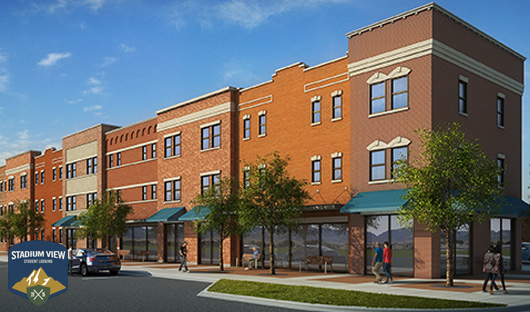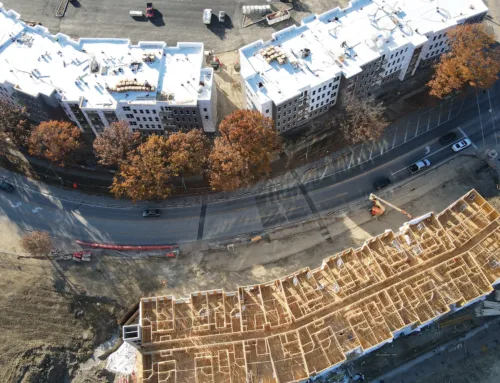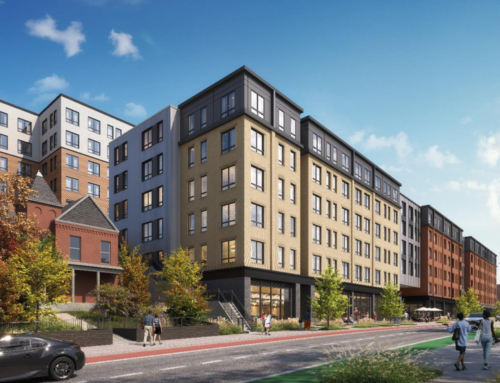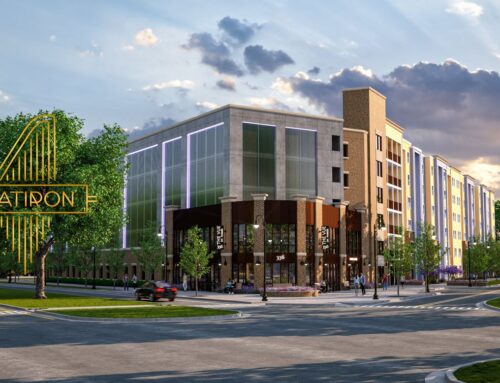Bozeman Daily Chronicle. June 7, 2015 by Eric Dietrich Chronicle Staff Writer
On an swath of former farmland on the south side of Bozeman, just west of Bobcat Stadium, a perimeter of massive, three-story apartment buildings is rising.
Brightly colored siding stands side-by-side with Tyvek-wrapped walls and bare plywood on structures in various stages of completion. A line of buildings facing 11th Avenue, a neat edge of vertical brick and glass, could rival most blocks on Main Street.
The complex, Stadium View Apartments, will soon house nearly 500 renters, most likely to be attending Montana State University just a short walk away. Watching workers traverse the site in trucks dwarfed by sharply angled roofs, it’s hard to believe that number isn’t higher.
When the apartments open this fall, they’ll inject some much-needed breathing room into the city’s crowded housing market — a partial reprieve for a city whose population has grown by more than 5,000 since 2010, including 2,000 new students at MSU.
Stadium View is one of several rental housing projects in progress around the city as the Gallatin Valley’s economy climbs out of the Great Recession. For Bozeman’s renters, slammed with years of rising rents, that development can’t come soon enough.
Read the original article or continue.
Downtown, staff in the HRDC housing office see the consequences — and say they worry about the increasing difficulty many of their working-class clients have finding and holding onto homes.
“Three or four years ago, folks could get into housing much more quickly,” said HRDC Housing Director Sara Savage. She’s seeing people forced to sleep on couches, in vehicles or even outside more often and for longer periods.
While HRDC administers federal grant money intended to help families in crisis avoid homelessness, Savage said it’s increasingly challenging to find apartments that meet the program’s price limits — $615 a month for one-bedroom units and $771 for two-bedrooms.
“Those numbers can be really hard to hit,” she said.
“The supply of the rentals is just crazy low,” said Brian Popiel, chairman of the Southwest Montana Building Industry Association. “I’d go borderline that we’re desperate.”
While he thinks the Stadium View complex will make a “huge difference,” he doesn’t see it as a complete solution to the several-thousand-rental-unit deficit the city has accumulated in recent years.
“We’re still a ways from building out of it,” he said.
A Chronicle analysis of the city’s rental market, based on census data, building permit records and MSU enrollment numbers supports Popiel’s assertion — and highlights the impact of MSU’s rapid growth amidst a housing market stalled by the downturn.
Since the 2010 U.S. Census, about 500 additional students have packed into the university’s dorms. Subtracting that number from the campus’s overall growth indicates an additional 1,500 students have joined the ranks of Bozeman rental-hunters.
Assuming half of the city’s new non-student arrivals are renting, that means the city has seen 3,200 additional renters in five years, 47 percent of them students. During the years of MSU’s fastest growth, 2010 to 2013, as much as 80 percent of the city’s annual population increase was driven by new students.
Between 2010 and last year, 888 new apartment units were permitted by the city, as well as 371 units of attached housing like townhomes and duplexes. If all the former and half the latter have ended up on the rental market by this year, the city’s current rental supply is up 1,070 units. That’s enough, at 2.3 renters per household, to house an only additional 2,470 people.
In a nutshell, this puts Bozeman behind the rental curve by 730 beds, or about 320 apartments short relative to its 2010 stock.
The 2010 census did count 828 vacant rental units, enough of a buffer to make up the difference and leave the city with a reasonably healthy 4.7 percent vacancy rate. However, that rosier outlook depends on the assumption that few of the city’s 2010 rentals have been converted to owner occupancy or placed on the vacation rental market. And with analogous price woes facing the city’s for-sale housing market, it may be that a greater proportion than 50 percent of city residents are renting.
A city planner who reviewed the Chronicle’s analysis, Chris Saunders, said he does think that a significant number of MSU students, perhaps a quarter, live outside city limits, and that 10 to 15 percent of the city’s new single-family homes are being used as rentals after being purchased by investors. He also estimates that the city has between 200 and 300 properties used as vacation rentals.
Anecdotes and other data — like the survey that famously pegged the city’s rental vacancy rate at “effectively zero” last fall — paint a somewhat starker picture than the Chronicle’s numbers. And simple supply and demand totals fail to account for the reality that the city’s more expensive apartments may be prohibitively expensive for lower-income renters, regardless of whether vacancies are available.
Additionally, rental building appears to have lagged behind Bozeman’s population growth, especially as MSU added more than 1,700 students in three years on the tail end of the recession between 2010 and 2013. Residential building, in contrast, only later began to rebound — just 23 multifamily housing units were permitted in 2011, compared to 121 in 2012 and 445 in 2013.
For its part, MSU — which is planning for 16,000 students by 2019 — says it has done everything it can to help, including constructing a new 400-bed dorm slated for completion in 2016.
“We’re sympathetic to the issue of rental costs within the community,” said MSU Spokesman Tracy Ellig. The university has added hundreds of beds to on-campus housing in recent years he said, opening the 72-bed Gallatin Hall in 2013, converting single-occupancy to double-occupancy rooms and using apartments in its family/graduate complex to house freshman students.
Though MSU has made its expansion plans public for years, Ellig said it’s only recently that the private sector has responded with projects like the Stadium View complex.
“That’s always been a bit of a puzzle to us,” said Ellig. “The university was always open and transparent about the fact that it was going to grow.”
The recession, he added, created a “perfect storm” for a housing crunch as it brought residential construction in Bozeman to a near halt at the same time MSU, like universities across the nation, saw attendance boom from students hoping to improve their career outlook.
Limiting enrollment would contradict MSU’s mission to provide an accessible education, Ellig also said. “We’re a public university,” he said. “Our doors are open so that people can come here and better themselves.”
He added he’s lived in Bozeman most of his life and that MSU has always been blamed for frustration with the city’s rental market.
“I think it grossly oversimplifies a complicated problem,” he said. “The marketplace can’t respond instantaneously.”
But respond, if slowly, the market has.
The city issued permits for 425 apartments and townhomes in 2014 — down a bit from 542 in 2013 but a drastic increase from 39 in 2011, a year MSU enrolled more than 800 additional students.
“We have an awful lot of multi-family housing coming online,” said Wendy Thomas, the city’s planning director. “We’ve made huge strides with rental.”
She estimates that, by the end of the year, Bozeman will see a few hundred new rentals open in addition to the Stadium View project’s 139 units, which range from studios to five-bedroom apartments.
On an affordability front, Thomas also said the city has made some progress toward goals articulated in a 2012 plan that called for the construction of an additional 240 affordable rental units.
For example, she said, HRDC and Missoula-based Summit Housing Group are working on developing the 48-unit Stoneridge Apartment. That project, subsidized by federal tax credits, is aimed at providing affordable rentals to households making between 40 and 60 percent of area median income.
A family of three at 40 percent of median income for Bozeman lives on about $25,600 a year, which translates into an affordable rent of approximately $700 a month.
When the thousands of low-income families in Bozeman can’t make those sorts of incomes pencil out, the consequences ripple outward. Homelessness or constantly swapping addresses makes it far harder to hold down job, or keep kids attending the same school, noted HRDC Housing Manager Savage.
“Several years ago, they could find housing.” she said. “They’re the ones that suffer.”





